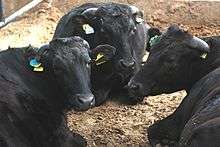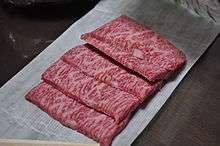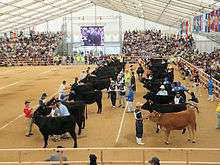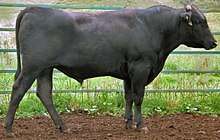Wagyu
Wagyu (和牛, Wa gyū, "Japanese cattle", pronounced [ɰa'ɡʲɯː]) is any of the four Japanese breeds of beef cattle.


In several areas of Japan, Wagyu beef is shipped carrying area names. Some examples are Matsusaka beef, Kobe beef, Yonezawa beef, Mishima beef,[1] Ōmi beef, and Sanda beef. In recent years, Wagyu beef has increased in fat percentage due to decrease in grazing and an increase in using feed, resulting in larger, fattier cattle.[2][3][4]
History

There are four breeds of Wagyu: Japanese Black (黒毛和種, Kuroge Washu), Japanese Polled (無角和種, Mukaku Washu), Japanese Brown (赤毛和種, Akage Washu or Akaushi) and Japanese Shorthorn (日本短角和種, Nihon Tankaku Washu).[5][6]
Japanese Black makes up 90% of all fattened cattle in Japan.[7] Strains of Japanese Black include Tottori, Tajima, Shimane and Okayama.[8] Japanese Brown, also known as Japanese Red,[7] is the other main breed;[8] strains include Kochi and Kumamoto. Japanese Shorthorn makes up less than one percent of all cattle in Japan.[9]
The idea that practices such as massaging cattle or feeding them beer could improve meat quality is a myth,[10] the result of misunderstanding.[11]:13
Australia

The Australian Wagyu Association is the largest breed association outside Japan.[12] Both fullblood and Wagyu-cross cattle are farmed in Australia for domestic and overseas markets, including Taiwan, China, Hong Kong, Singapore, Malaysia, Indonesia, the U.K., France, Germany, Denmark and the U.S.[13] Australian Wagyu cattle are grain fed for the last 300–500 days of production. Wagyu bred in Western Australia's Margaret River region often have red wine added to their feed as well.[14]
United States
In the United States, some Japanese Wagyu cattle are bred with Aberdeen Angus cattle. This crossbreed has been named American Style Kobe Beef.[15] Wagyu were first competitively exhibited at the National Western Stock Show in 2012.[16] Other U.S. Wagyu breeders have full-blooded animals directly descended from original Japanese bloodlines, that are registered through the American Wagyu Association.[17]
Canada
Wagyu cattle farming in Canada appeared after 1991 when the Canadian Wagyu Association was formed. Wagyu style cattle and farms in Canada are found only in Alberta,[18] Ontario,[19] Quebec[20] and Prince Edward Island.[21] Canadian Wagyu beef products are exported to the U.S. (including Hawaii), Australia, New Zealand, and Europe.[21]
United Kingdom
In 2008, a herd of Wagyu cattle was imported to North Yorkshire, with the first produce becoming available in 2011.[22] Since 2011 there have been Wagyu herds in Scotland.[23][24][25][26][27]
The Wagyu Breeders Association Ltd was established in July 2014.[28]
References
- "NGRC Bos taurus". www.nodai-genome.org. Archived from the original on 23 February 2016. Retrieved 6 May 2018.
- Gotoh, Takafumi (July 2018). "The Japanese Wagyu beef industry: current situation and future prospects – A review". Asian-Australasian Journal of Animal Sciences. 31: 942–47. doi:10.5713/ajas.18.0333. S2CID 49693378 – via Science Citation Index.
- Ogino, Mizuna; Matsuura, Akihiro; Yamazaki, Atusi; Irimajiri, Mami; Takahashi, Hideyuki; Komatsu, Tokushi; Kushibiki, Shiro; Shingu, Hiroyuki; Kasuya, Etsuko (17 January 2013). "Biological rhythms related to metabolism in Japanese Shorthorn cattle under varying environments and management techniques". Animal Science Journal. 84 (6): 513–26. doi:10.1111/asj.12029. ISSN 1344-3941. PMID 23607269.
- Higuchi, Mikito; Shiba, Nobuya; Imanri, Mai; Yonai, Miharu; Watanabe, Akira (1 April 2018). "Effects of Grazing or Exercise in the Middle of the Fattening Period on the Growth and Carcass Traits of Japanese Shorthorn Steers". Japan Agricultural Research Quarterly. 52 (2): 163–72. doi:10.6090/jarq.52.163. ISSN 0021-3551.
- Porter, Valerie; Mason, Ian Lauder (2002). Mason's world dictionary of livestock breeds, types, and varieties. CABI. p. 66. ISBN 978-0-85199-430-7.
- "What Is Wagyu?". Japan Meat Information Service Center. Archived from the original on 22 October 2013.
- "Wagyu Japanese Beef" (PDF). Archived (PDF) from the original on 25 January 2013.
- "Wagyu – What are they? Where did they come from?". Archived from the original on 5 January 2013.
- "Japanese Shorthorn Cattle". Archived from the original on 30 August 2012.
- Daniel Krieger (26 August 2010). "All for the love of Tajima cows" Archived 9 November 2014 at the Wayback Machine. The Japan Times. Accessed January 2017.
- Kiyoshi Namikawa (1985). Breeding History of Japanese Beef Cattle and Preservation of Genetic Resources as Economic Farm Animals. In: Proceedings of Washington State University 3rd Wagyu Symposium, Washington, USA, pp. 1–28. Archived 15 April 2012.
- "Australian Wagyu Forum". Archived from the original on 10 April 2013.
- Exports Archived 10 March 2011 at the Wayback Machine; Australian Wagyu Association; accessed .
- "Archived copy". Archived from the original on 25 January 2014. Retrieved 1 March 2014.CS1 maint: archived copy as title (link)
- U.S. ranches breed famous Kobe-style beef Archived 28 August 2011 at the Wayback Machine; 12 August 2011 article in The Japan Times" (from the Associated Press); p. 3; accessed .
- Raabe, Steve (11 January 2012). "Tender Wagyu muscles onto meat scene, makes stock-show exhibition debut". The Denver Post. Archived from the original on 13 January 2012.
- "Registration – DNA Tests – American Wagyu Association". wagyu.org. Archived from the original on 1 October 2017. Retrieved 6 May 2018.
- Kobe beef on P.E.I.? Veterinarian raising wagyu cattle Archived 6 December 2014 at the Wayback Machine; The Chronicle Herald online; accessed .
- Kuntz First to Breed Wagyu in Ontario Archived 4 March 2016 at the Wayback Machine; The Post South Bruce; accessed .
- "Accueil – Wagyu Québec – Éleveurs Wagyu / Wagyu Breeders". www.wagyuquebec.com. Retrieved 29 November 2019.
- About Us; Canadian Wagyu online; accessed.
- Wainwright, Martin (7 February 2008). "World's dearest beef to be sold in Yorkshire". The Guardian. Archived from the original on 11 October 2017. Retrieved 11 October 2017.
- "Try a little tenderness: on the farm with Scotland's Wagyu cattle". The Herald. Archived from the original on 13 April 2013. Retrieved 19 November 2012.
- "Scottish farm to make Japanese Wagyu beef". The Scotsman. Archived from the original on 30 July 2013. Retrieved 29 July 2013.
- "Highland Wagyu beef firm in expansion drive". BBC News. 29 July 2013. Archived from the original on 1 August 2013. Retrieved 29 July 2013.
- "Perthshire - the Wagyu centre of Europe". The Scottish Farmer. Archived from the original on 10 August 2014. Retrieved 1 August 2013.
- "spreading the wagyu message". scottish farmer. Archived from the original on 1 December 2017. Retrieved 18 July 2017.
- "The Association". British Wagyu. Archived from the original on 11 October 2017. Retrieved 11 October 2017.
Further reading
- Hongo, Jun (6 July 2010). "Despite 'wagyu's' history, foot-and-mouth hit hard". FYI (weekly column). The Japan Times.
- "Why Wagyu Beef Is So Expensive". Business Insider. 27 July 2019.
External links
| Wikimedia Commons has media related to Wagyū. |
- Wagyu Registry Association (in Japanese)
- Wagyu International
- American Wagyu Association
- Australian Wagyu Association
- German Wagyu Association (in German, English, and Spanish)
- Wagyu Research and Information – Department of Animal Sciences, Washington State University